CHRYSLER TOWN AND COUNTRY 2014 5.G Owners Manual
Manufacturer: CHRYSLER, Model Year: 2014, Model line: TOWN AND COUNTRY, Model: CHRYSLER TOWN AND COUNTRY 2014 5.GPages: 703, PDF Size: 5.35 MB
Page 101 of 703
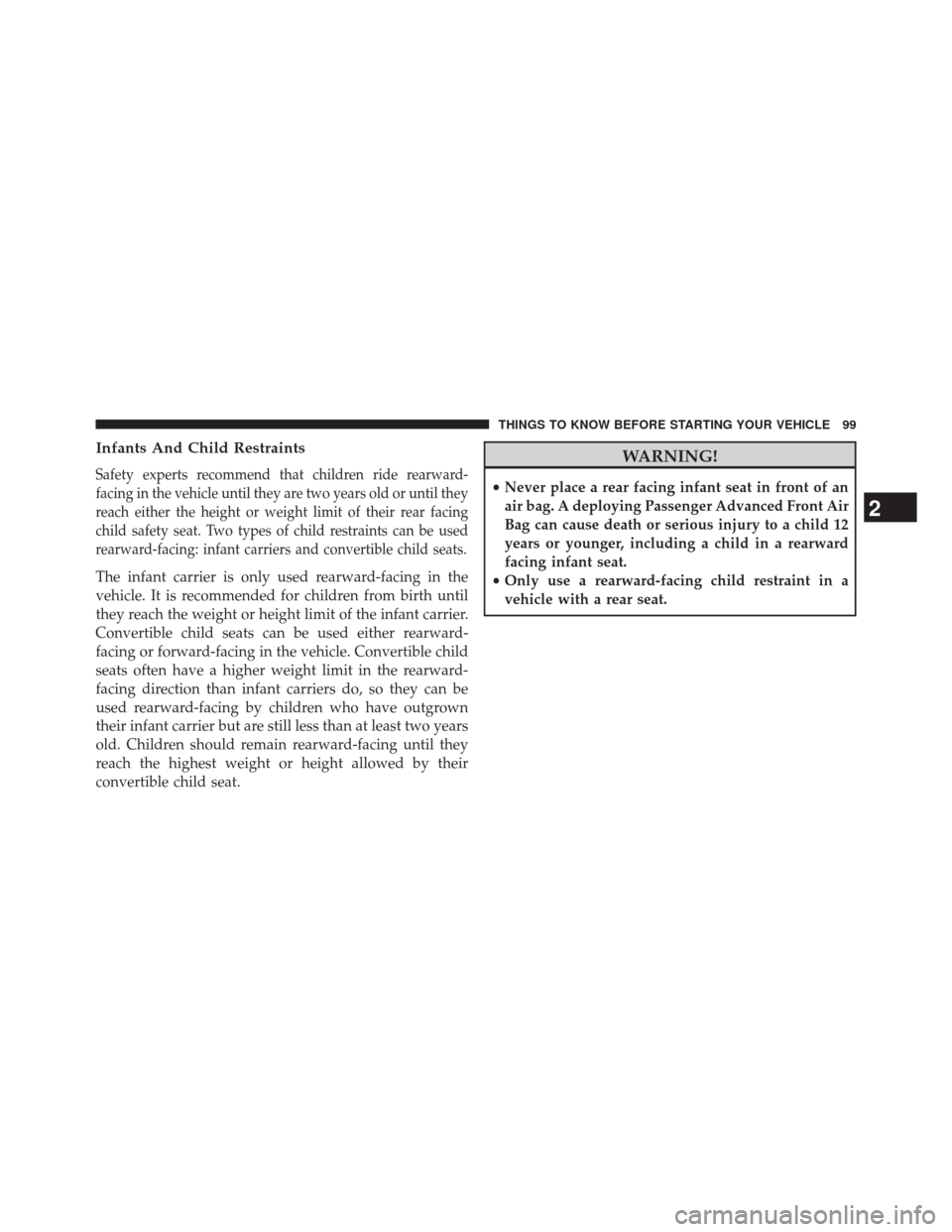
Infants And Child Restraints
Safety experts recommend that children ride rearward-
facing in the vehicle until they are two years old or until they
reach either the height or weight limit of their rear facing
child safety seat. Two types of child restraints can be used
rearward-facing: infant carriers and convertible child seats.
The infant carrier is only used rearward-facing in the
vehicle. It is recommended for children from birth until
they reach the weight or height limit of the infant carrier.
Convertible child seats can be used either rearward-
facing or forward-facing in the vehicle. Convertible child
seats often have a higher weight limit in the rearward-
facing direction than infant carriers do, so they can be
used rearward-facing by children who have outgrown
their infant carrier but are still less than at least two years
old. Children should remain rearward-facing until they
reach the highest weight or height allowed by their
convertible child seat.
WARNING!
•Never place a rear facing infant seat in front of an
air bag. A deploying Passenger Advanced Front Air
Bag can cause death or serious injury to a child 12
years or younger, including a child in a rearward
facing infant seat.
• Only use a rearward-facing child restraint in a
vehicle with a rear seat.
2
THINGS TO KNOW BEFORE STARTING YOUR VEHICLE 99
Page 102 of 703
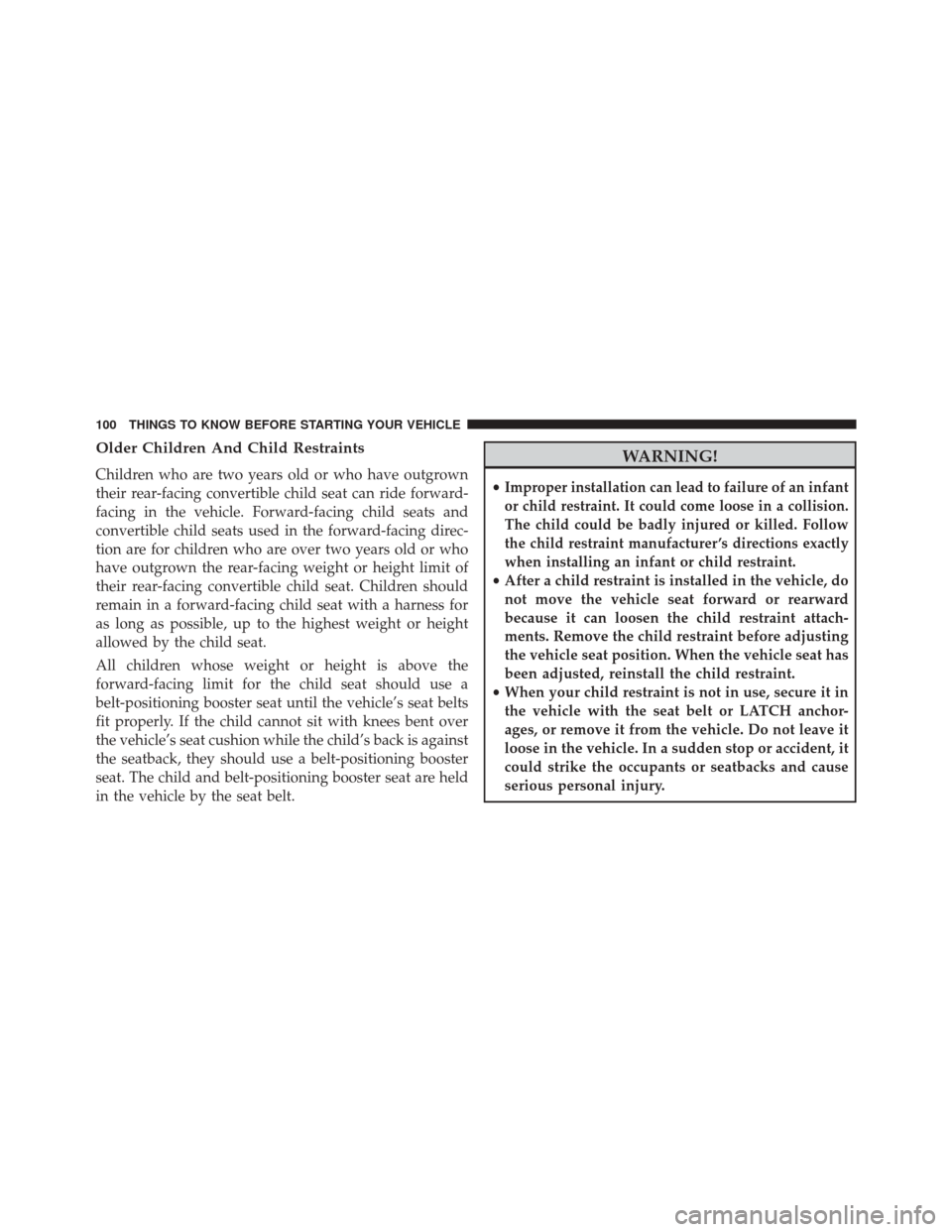
Older Children And Child Restraints
Children who are two years old or who have outgrown
their rear-facing convertible child seat can ride forward-
facing in the vehicle. Forward-facing child seats and
convertible child seats used in the forward-facing direc-
tion are for children who are over two years old or who
have outgrown the rear-facing weight or height limit of
their rear-facing convertible child seat. Children should
remain in a forward-facing child seat with a harness for
as long as possible, up to the highest weight or height
allowed by the child seat.
All children whose weight or height is above the
forward-facing limit for the child seat should use a
belt-positioning booster seat until the vehicle’s seat belts
fit properly. If the child cannot sit with knees bent over
the vehicle’s seat cushion while the child’s back is against
the seatback, they should use a belt-positioning booster
seat. The child and belt-positioning booster seat are held
in the vehicle by the seat belt.
WARNING!
•Improper installation can lead to failure of an infant
or child restraint. It could come loose in a collision.
The child could be badly injured or killed. Follow
the child restraint manufacturer ’s directions exactly
when installing an infant or child restraint.
• After a child restraint is installed in the vehicle, do
not move the vehicle seat forward or rearward
because it can loosen the child restraint attach-
ments. Remove the child restraint before adjusting
the vehicle seat position. When the vehicle seat has
been adjusted, reinstall the child restraint.
• When your child restraint is not in use, secure it in
the vehicle with the seat belt or LATCH anchor-
ages, or remove it from the vehicle. Do not leave it
loose in the vehicle. In a sudden stop or accident, it
could strike the occupants or seatbacks and cause
serious personal injury.
100 THINGS TO KNOW BEFORE STARTING YOUR VEHICLE
Page 103 of 703
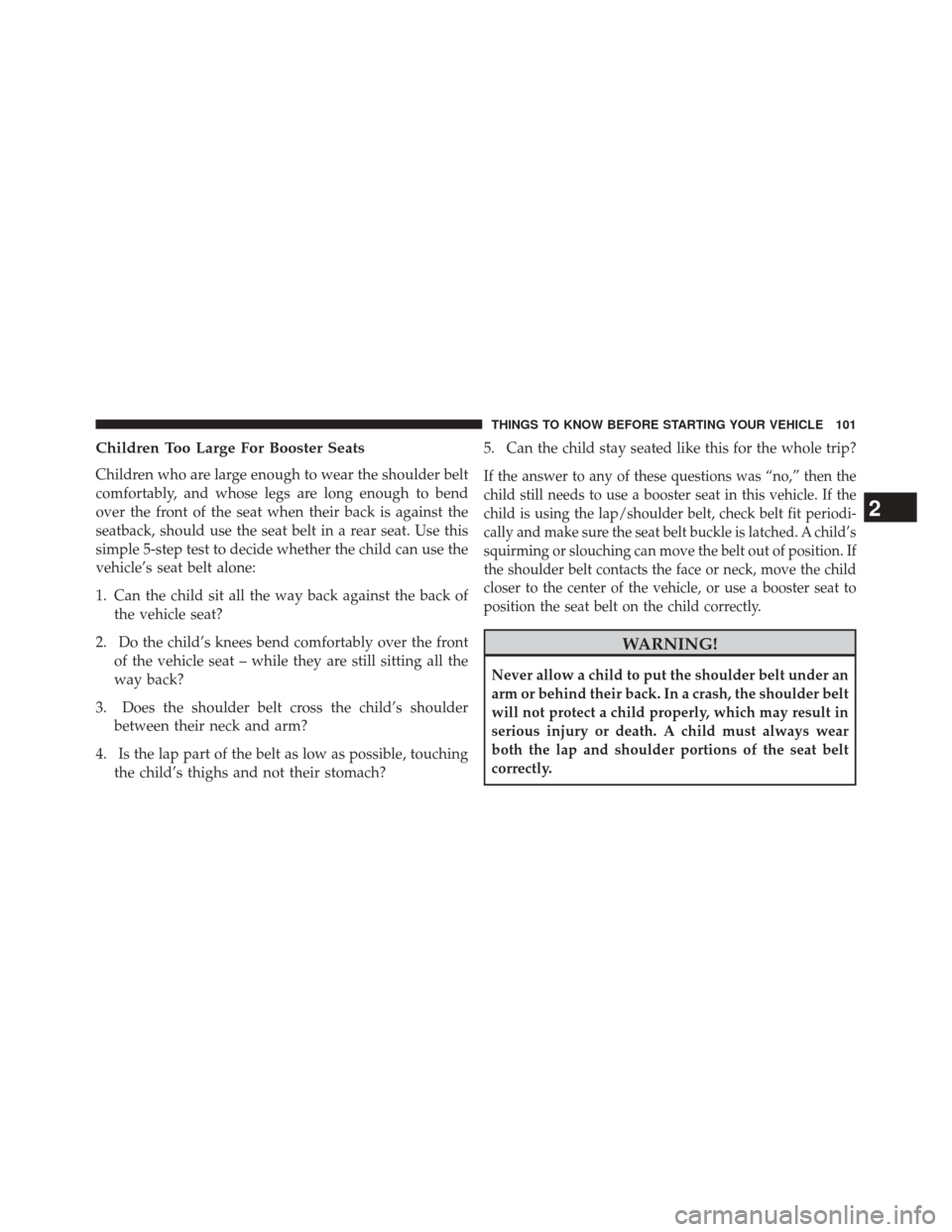
Children Too Large For Booster Seats
Children who are large enough to wear the shoulder belt
comfortably, and whose legs are long enough to bend
over the front of the seat when their back is against the
seatback, should use the seat belt in a rear seat. Use this
simple 5-step test to decide whether the child can use the
vehicle’s seat belt alone:
1. Can the child sit all the way back against the back ofthe vehicle seat?
2. Do the child’s knees bend comfortably over the front of the vehicle seat – while they are still sitting all the
way back?
3. Does the shoulder belt cross the child’s shoulder between their neck and arm?
4. Is the lap part of the belt as low as possible, touching the child’s thighs and not their stomach? 5. Can the child stay seated like this for the whole trip?If the answer to any of these questions was “no,” then the
child still needs to use a booster seat in this vehicle. If the
child is using the lap/shoulder belt, check belt fit periodi-
cally and make sure the seat belt buckle is latched. A child’s
squirming or slouching can move the belt out of position. If
the shoulder belt contacts the face or neck, move the child
closer to the center of the vehicle, or use a booster seat to
position the seat belt on the child correctly.
WARNING!
Never allow a child to put the shoulder belt under an
arm or behind their back. In a crash, the shoulder belt
will not protect a child properly, which may result in
serious injury or death. A child must always wear
both the lap and shoulder portions of the seat belt
correctly.
2
THINGS TO KNOW BEFORE STARTING YOUR VEHICLE 101
Page 104 of 703
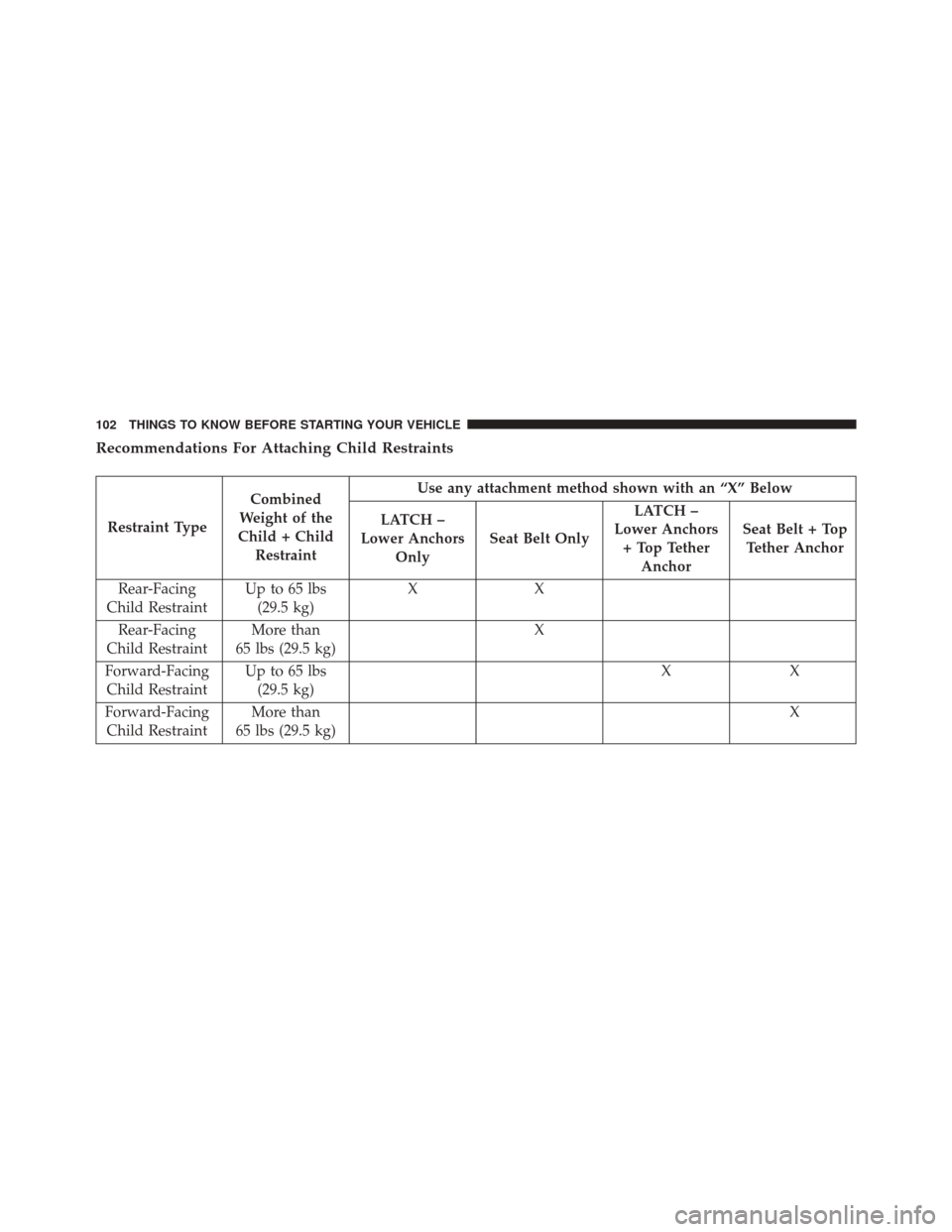
Recommendations For Attaching Child Restraints
Restraint TypeCombined
Weight of the
Child + Child Restraint Use any attachment method shown with an “X” Below
LATCH –
Lower Anchors Only Seat Belt Only LATCH –
Lower Anchors + Top Tether Anchor Seat Belt + Top
Tether Anchor
Rear-Facing
Child Restraint Up to 65 lbs
(29.5 kg) XX
Rear-Facing
Child Restraint More than
65 lbs (29.5 kg) X
Forward-Facing Child Restraint Up to 65 lbs
(29.5 kg) XX
Forward-Facing Child Restraint More than
65 lbs (29.5 kg) X
102 THINGS TO KNOW BEFORE STARTING YOUR VEHICLE
Page 105 of 703
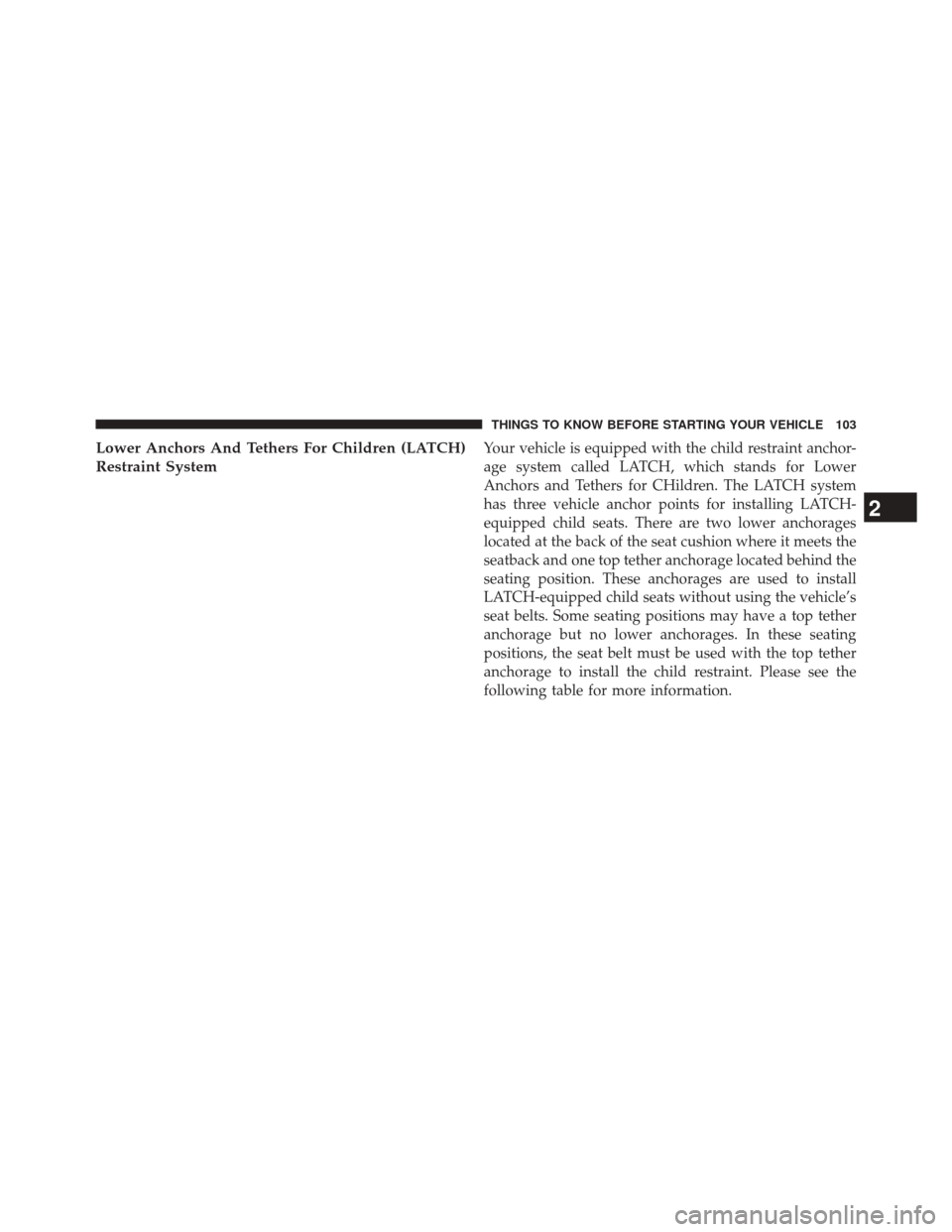
Lower Anchors And Tethers For Children (LATCH)
Restraint SystemYour vehicle is equipped with the child restraint anchor-
age system called LATCH, which stands for Lower
Anchors and Tethers for CHildren. The LATCH system
has three vehicle anchor points for installing LATCH-
equipped child seats. There are two lower anchorages
located at the back of the seat cushion where it meets the
seatback and one top tether anchorage located behind the
seating position. These anchorages are used to install
LATCH-equipped child seats without using the vehicle’s
seat belts. Some seating positions may have a top tether
anchorage but no lower anchorages. In these seating
positions, the seat belt must be used with the top tether
anchorage to install the child restraint. Please see the
following table for more information.
2
THINGS TO KNOW BEFORE STARTING YOUR VEHICLE 103
Page 106 of 703
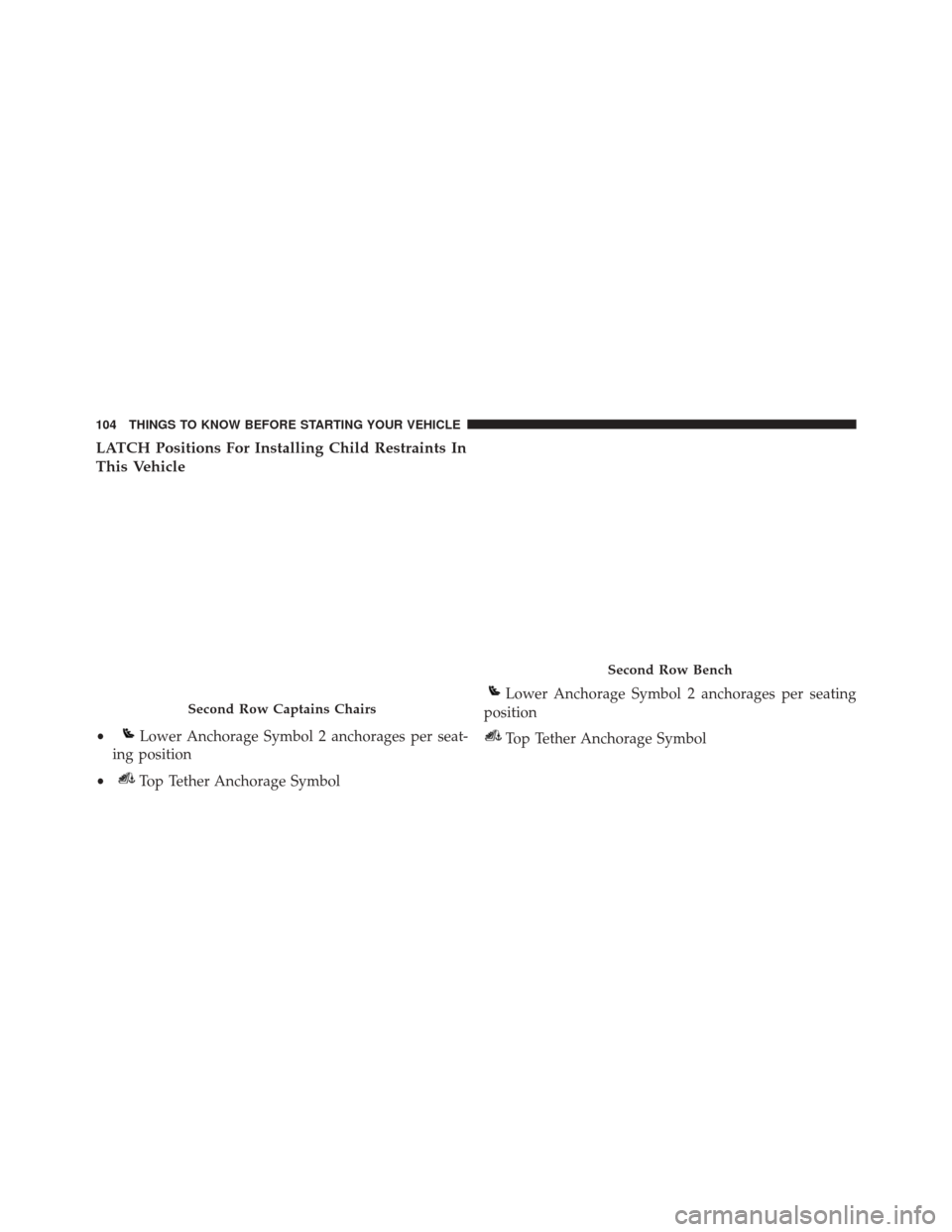
LATCH Positions For Installing Child Restraints In
This Vehicle
Second Row Captains Chairs
•Lower Anchorage Symbol 2 anchorages per seat-
ing position
•
Top Tether Anchorage Symbol
Second Row Bench
Lower Anchorage Symbol 2 anchorages per seating
position
Top Tether Anchorage Symbol
104 THINGS TO KNOW BEFORE STARTING YOUR VEHICLE
Page 107 of 703
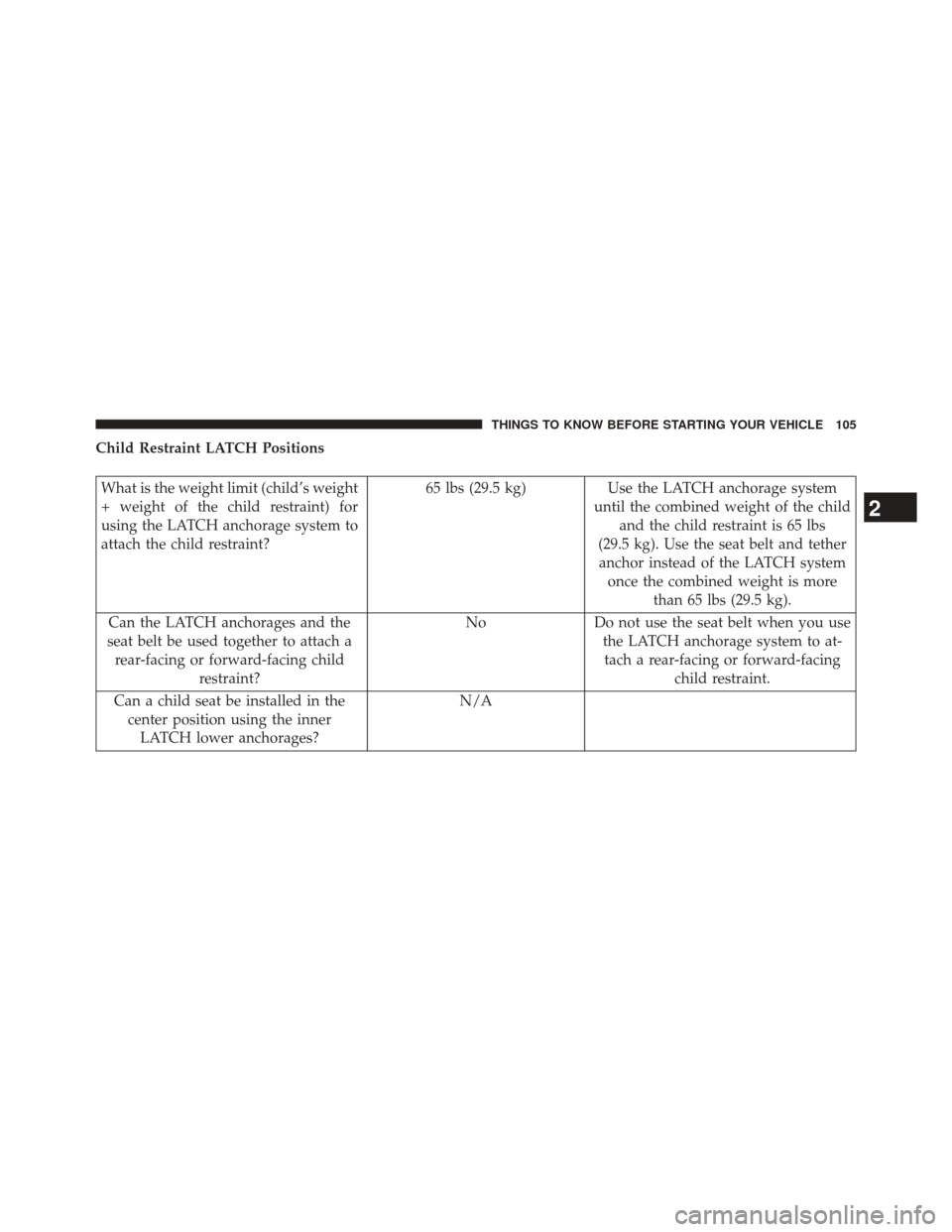
Child Restraint LATCH Positions
What is the weight limit (child’s weight
+ weight of the child restraint) for
using the LATCH anchorage system to
attach the child restraint?65 lbs (29.5 kg) Use the LATCH anchorage system
until the combined weight of the childand the child restraint is 65 lbs
(29.5 kg). Use the seat belt and tether anchor instead of the LATCH system once the combined weight is more than 65 lbs (29.5 kg).
Can the LATCH anchorages and the
seat belt be used together to attach a rear-facing or forward-facing child restraint? No Do not use the seat belt when you use
the LATCH anchorage system to at-tach a rear-facing or forward-facing child restraint.
Can a child seat be installed in the center position using the innerLATCH lower anchorages? N/A
2
THINGS TO KNOW BEFORE STARTING YOUR VEHICLE 105
Page 108 of 703
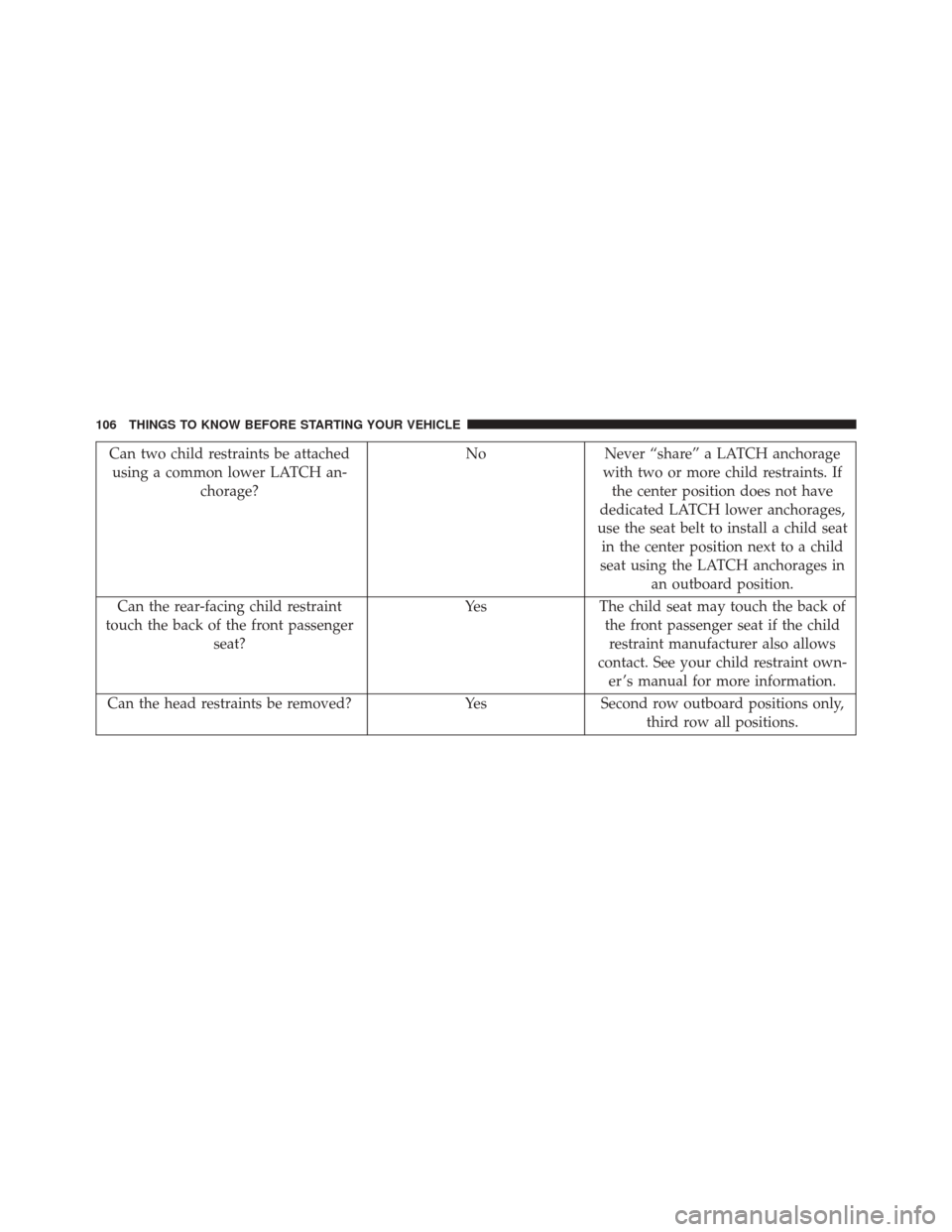
Can two child restraints be attachedusing a common lower LATCH an- chorage? No Never “share” a LATCH anchorage
with two or more child restraints. Ifthe center position does not have
dedicated LATCH lower anchorages,
use the seat belt to install a child seat in the center position next to a child
seat using the LATCH anchorages in an outboard position.
Can the rear-facing child restraint
touch the back of the front passenger seat? Yes The child seat may touch the back of
the front passenger seat if the childrestraint manufacturer also allows
contact. See your child restraint own- er ’s manual for more information.
Can the head restraints be removed? Yes Second row outboard positions only, third row all positions.
106 THINGS TO KNOW BEFORE STARTING YOUR VEHICLE
Page 109 of 703
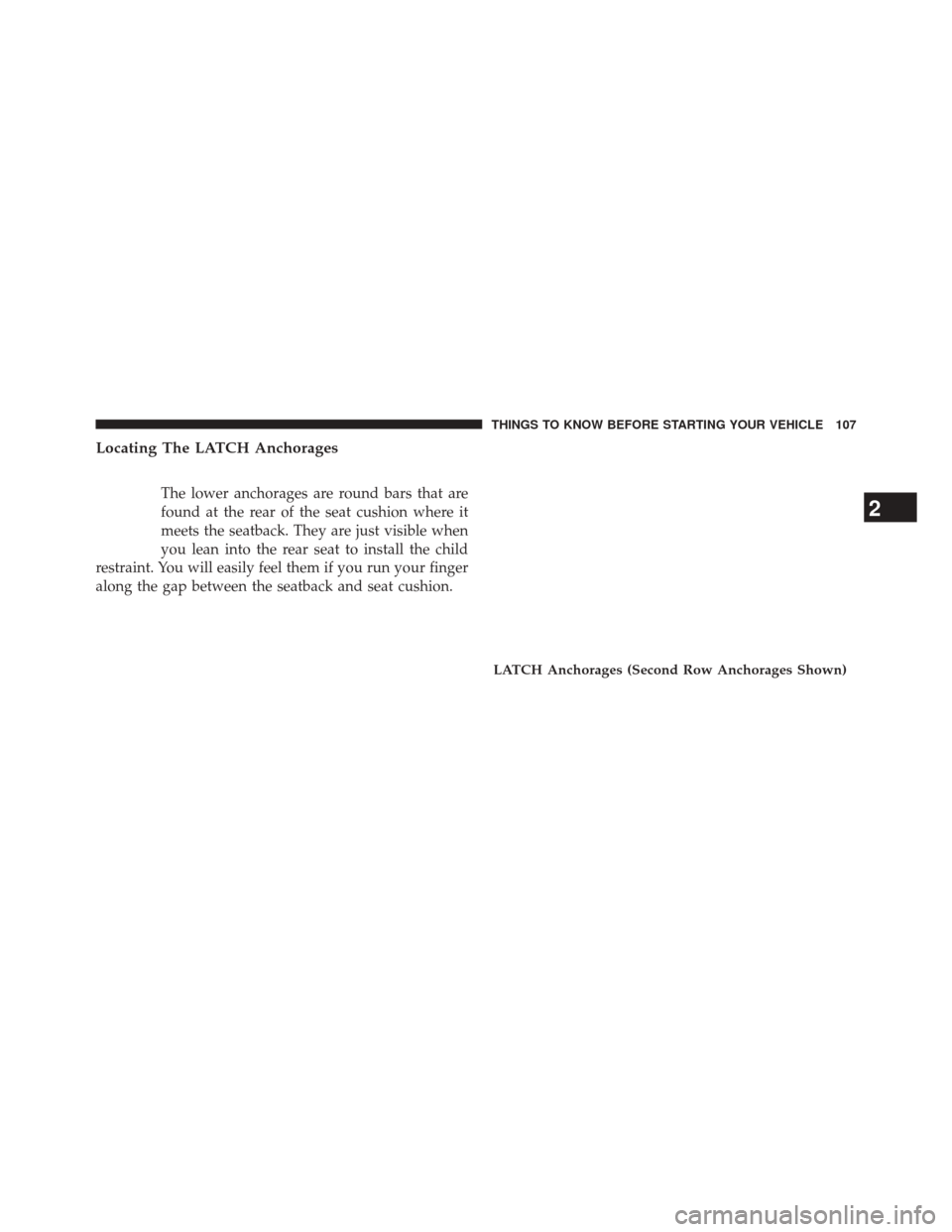
Locating The LATCH Anchorages
The lower anchorages are round bars that are
found at the rear of the seat cushion where it
meets the seatback. They are just visible when
you lean into the rear seat to install the child
restraint. You will easily feel them if you run your finger
along the gap between the seatback and seat cushion.
LATCH Anchorages (Second Row Anchorages Shown)
2
THINGS TO KNOW BEFORE STARTING YOUR VEHICLE 107
Page 110 of 703

Locating The LATCH Anchorages
In addition, there are tether strap anchors lo-
cated behind each rear seatback, near to the
floor.
LATCH Anchorages (Third Row 60/40 AnchoragesShown)
LATCH Anchorages (Third Row 60/40 AnchorageShown)
108 THINGS TO KNOW BEFORE STARTING YOUR VEHICLE